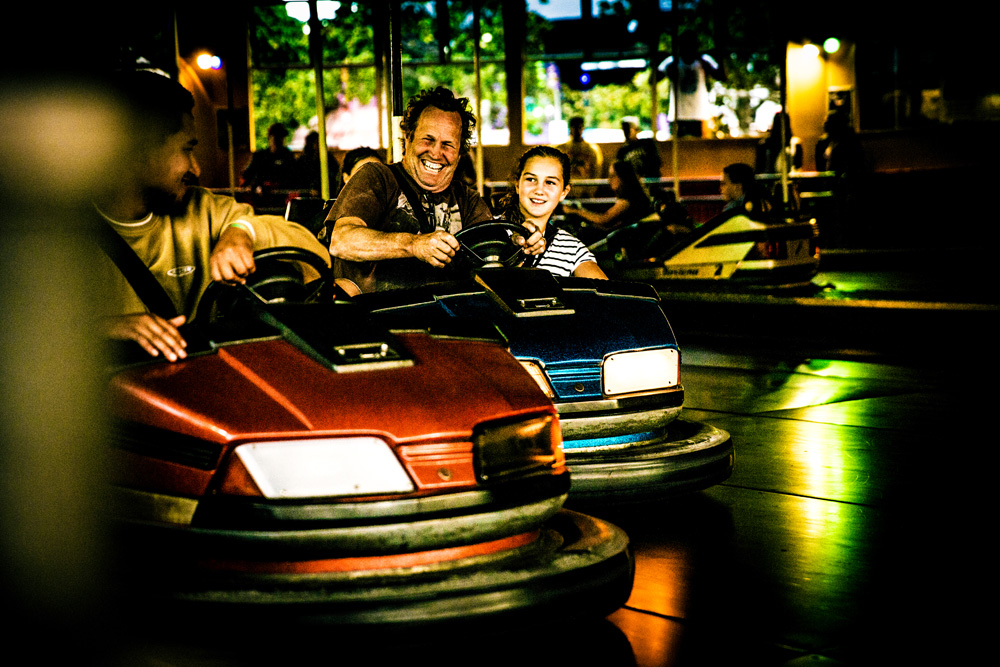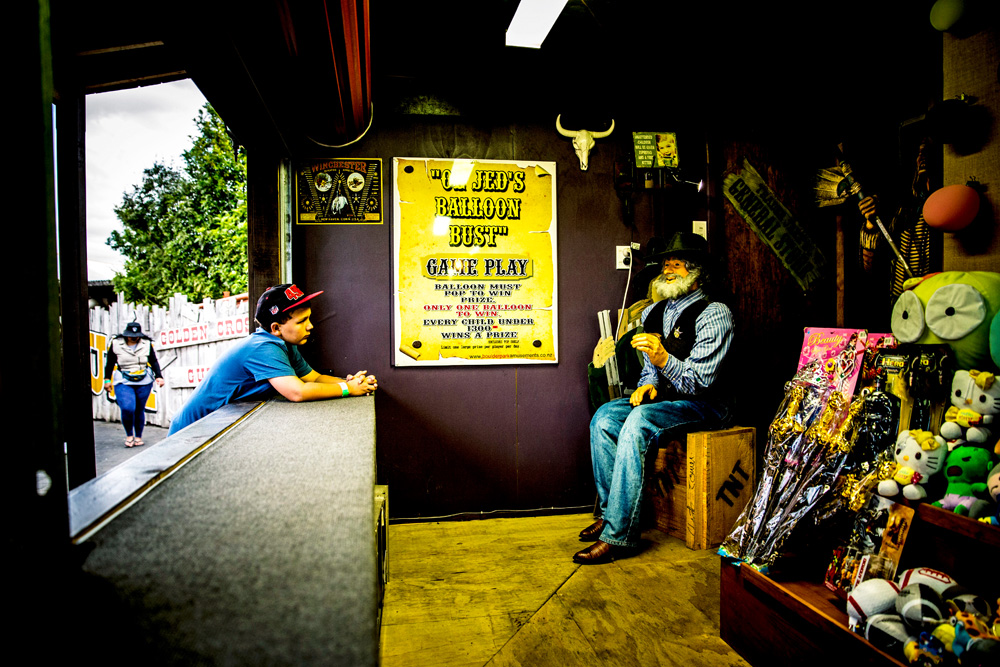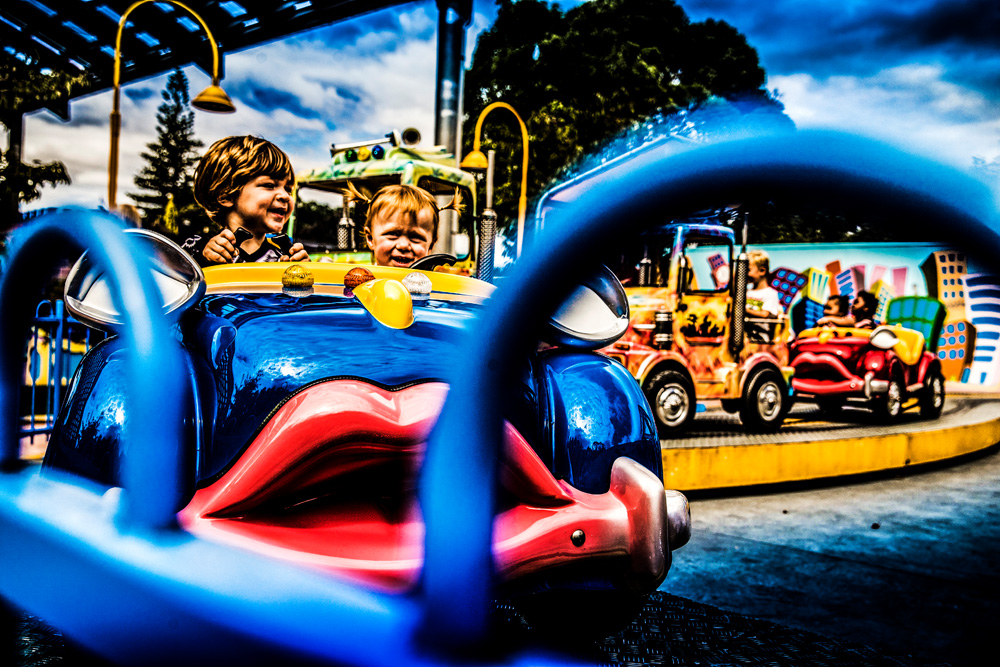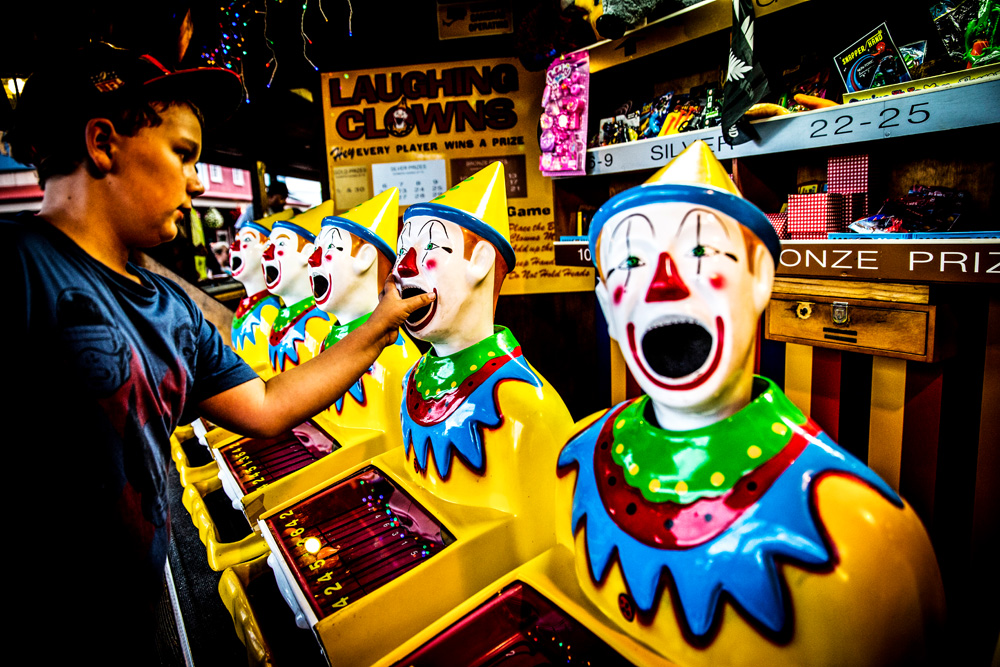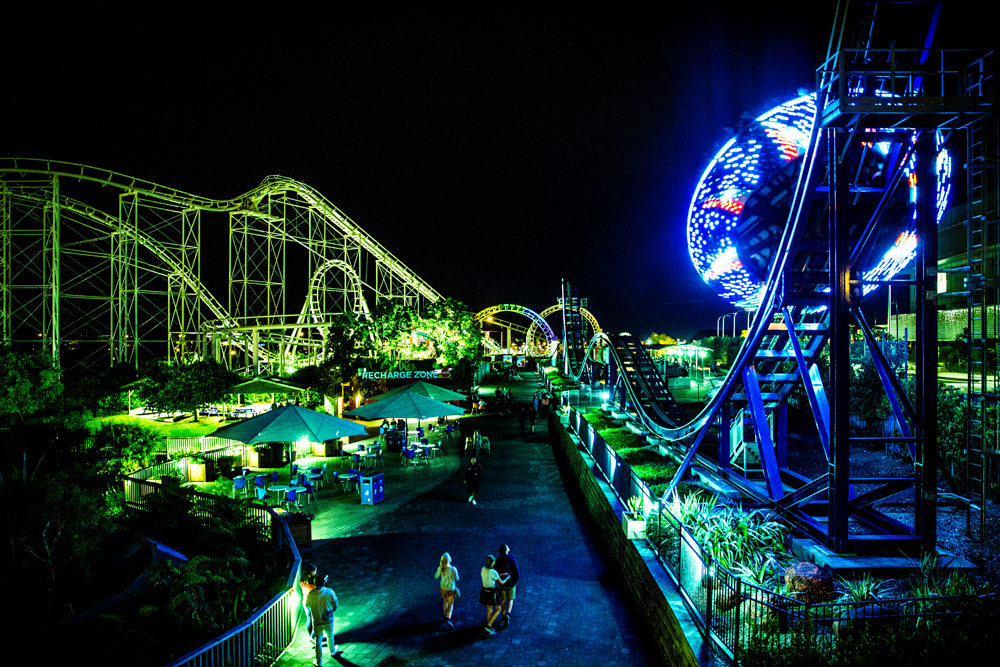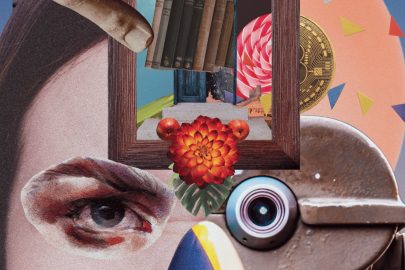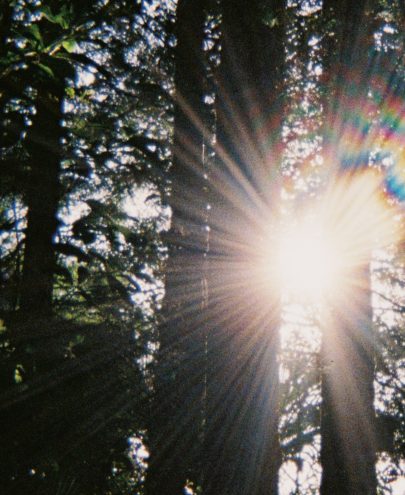Jul 2, 2015 What's On
Photos by Vicki Leopold. This story first appeared in the May 2015 issue of Metro
It is clear and cold when we arrive at Rainbow’s End on a Saturday, with a southerly driving through the Manukau sprawl. There are four of us. My wife, Louise, and I had both been before and we brought Mike and Bronwyn, two friends from Hamilton who had never visited Rainbow’s End, as controls, to make it a fair test.
I had visited once, circa 1995. I had been bombarded with advertisements for the Gold Rush, which was Rainbow’s End’s newest ride, while I watched What Now and after-school cartoons. I remember children piling into mine cars, and a plastic miner yelling, “Look out!” The ads segued seamlessly in and out of the cartoons I watched. Wile E Coyote’s Wild West was, somehow, also the one at Rainbow’s End, with all the mystery and mayhem that promised. Danger! Roadrunners! Excitement! Gold! Sudden death? Then there was the Coca-Cola Corkscrew rollercoaster; an unknown and longed-for entity. I dreamed, often literally, of roller-coasters. The first story I ever had published was a lavishly illustrated story of a fictional trip to the Gold Coast’s Dreamworld entitled Where The Rollercoasters Are. My mum sent it to a Christian home-schooling journal and they printed it, sans illustrations. I dreamed of Rainbow’s End, like 10,000 other Kiwi kids, and when I finally got to go it was a pilgrimage, as to a holy shrine.
Now I am back, for a kind of nostalgia-vs-cynicism grudge match. Leaving the car, someone has left a McDonald’s sundae next to our carpark, mysteriously intact, unmelted. Was it a sign of some kind, an oblique omen? (It was not.)
The gates of Rainbow’s End are scrappy, despite a recent coat of paint. They speak of age and the passage of many people. On the exit side is painted “IF YOU HAD A GREAT TIME, PLEASE TELL YOUR FRIENDS!” The pillar next to it reads “IF YOU DIDN’T, PLEASE TELL US!” Near them I spot Rai and Bow, the park’s mascots, posing for photos with some children. They are deeply weird. I don’t mind mascots that resemble fantastic creatures — Donald Duck, for instance, is fundamentally unworrying — but the new versions of Rai and Bow are terrifying caricatures of humanity. They look like they roam the park at night in search of human flesh. They’re a stark contrast to the old Rai and Bow, fuzzy, loveable monster-critters who used to feature in all the ads I remember from my childhood, the ones with the barbershop quartet singing: “Take me back to the rainbow/That rainbow kind of magic/RainbowdidyrainbowdidyRainbow’s End/That’s Rainbow Magic/Great fun, fun fun, at rain, rain, rain/BOW’S END.”
Mike and I develop a habit of breaking into the theme song, which we sing, off-key, in queues. It annoys Louise and Bronwyn greatly, and from the looks that the ride attendants give us, I doubt this is a new thing.
AJ Chapman would have been used to it. He’s 26, single, and he works in radio, at Mediaworks. Before that, he worked at Rainbow’s End. He started as a cashier, before graduating to the entertainment department, where he worked as a mascot.
“There were all sorts of costumes — the Rai and Bow costumes, Kitty Cool, Power Pup. Kitty Cool was a lot easier to wear than Power Pup. In Power Pup, you couldn’t see anything.”
A mascot! I’m thrilled; I’ve always wanted to talk to one. The most important question: did he get kicked in the balls?
“I remember I was Power Pup, and a four-year-old girl — who was pretty excited to see me, and wanted to give me a hug, jumped into my arms and collected my crotch with her knee. So I finished the hug, and went into an alley and collapsed on the ground.”
Kids aren’t the problem, he explains. The mascot costumes have a curious effect on adults. They break down normal barriers but, in doing so, people stop thinking of the mascot as human.
“Sometimes adults, they’ll hug you, and they’ll want to get a bit rough and tumble, try and tackle you to the ground. But I’m quite a big character myself, and I can get quite firm with them. There were times when… well, I wouldn’t punch them, but give them a helpful shove, remind them that there’s an actual person in there. “Come on mate, I’m a person, you’ll get done for assault.”
At the park, some kids are pestering the modern, terrifying Rai and Bow with love in their eyes, but nothing more. We follow a dilapidated sign — a weathered, emparroted pirate with a fixed grin — to the good ship “Esmeralda”. The Pirate Ship ride, an imposing chunk of fibreglass on a pendulum, opened in 1983, one year after the park itself, and the same year I was born. The cold has kept queues short. We shuffle in with a bunch of adults and children ranging in age from primary school to mid-teen, and sit at the back, where memory tells me the ride is wildest. The fibreglass is cracked with age and from countless kicks from kids. A fat blob of grease sits on some of the internal structure visible through one of the cracks. Mike eyes it doubtfully. This is not a good start.
The lap-bars come down. The attendant drones a safety warning and a speaker burbles a torrent of unintelligible gibberish. About the only part I can make out is something along the lines of “Don’t try to get off the ride.” My expectations, already low, plummet.
I laugh so hard I cry. It is the most ridiculously fun thing ever.
It starts slowly, inducing a kind of gentle nausea, but soon we are swinging high. There’s a blast of air on each downswing, a moment of weightlessness on the up, and each is accompanied by the feeling of your gut being fundamentally unimpressed with this turn of events. It prompts an autonomous reaction. For some, this is undoubtedly an up-chuck; for us, and others on the ride, it is wholly unexpected laughter. We laugh wild and long. I laugh so hard I cry. It is the most ridiculously fun thing ever.
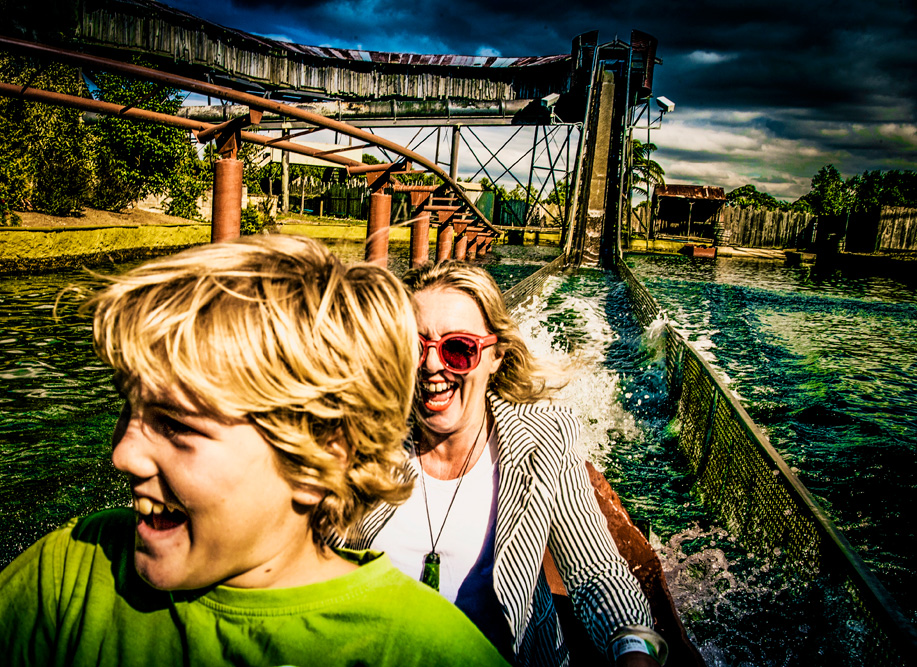
“Have you,” I ask Rainbow’s End CEO Chris Deere, “ever played Roller-coaster Tycoon?”
I am at Rainbow’s End on a different day — the weather indifferent and spotting with rain, as opposed to clear and icy — and I am anxious to know whether he plays this popular entry game in the Sim genre, in which you run a theme park as well or as incompetently as you like. I hope he does. It’d be like a farmer who nipped home early from the shearing to play Farmville.
Deere laughs. “No, but I must check it out!” he says. It’s slightly disappointing, but that’s okay, because he’s an entirely likeable bloke. Deere is a young-looking 47, a former front-line cop who also worked in youth aid, before being “tapped”, as he puts it, to join the Rainbow’s End crew, and rising to CEO. He has very much the air of a friendly community constable, with sharp blue eyes and hair greying at the temples. He even dresses like an off-duty cop, sporting a black blazer and a blue shirt. His office is full of park paraphernalia. Letters from grateful children adorn the walls, and there’s a guitar in a case, leaning against his desk. It belongs to one of his sons, who are aged 12 and nine.
Chris Deere loves Rainbow’s End. He never says as much, but he’s clearly head over heels. His love moves through him and flows out of him as we wander through the park wishing employees “morning” en route to the Incredible Room.
The Incredible Room is one of seven Birthday Rooms; the others being Awesome, Amazing, Fantastic, Magnificent, Coolest, and Greatest. What makes them superlative is some nifty tech that offers birthday kids an interactive cartoon. They watch a screen where a character — a monkey, or a panda, or something else — appears to be doing the usual cartoon things, but then starts addressing them by name. This sounds like the stuff of a horror movie, but I can see how eight-year-old me would have loved it. Deere takes me for a look backstage, where a crew operates a CCTV camera and a set of computer controls. Another provides the voice of the cartoon character, whose mouth movement syncs up to the operator’s voice. There’s a custom keyboard with things marked on it like “Dance” and “Wave”. I have a bit of a tinker and watch a cartoon character dance to my instructions and say “Hi!” with my voice. Incredible.
My wife, my friends and I are waiting in line for the Scorpion Karts. Whether they deserve to be named after a venomous desert lobster is debatable. They simply aren’t that fast. To an adult — and this is what I realised I was now, aged 31 and surrounded by 13-year-olds — standing in the queue, they promise all the fun of lawn-mowing with none of the satisfaction of a job well done.
The 13-year-olds are not cynical, though. The bunch in front of us are a mix of Maori and Pasifika kids who could have been locals, and who were keenly evaluating the relative strengths of the karts as they waited. They ran for the karts as soon as the barrier went up. “I’m gonna get number eight, bro, it’s fucking mean!” one of the kids yells. He does. The karts are marshalled by some weary-looking attendants and the race begins.
The karts go out in single file and they’re all limited to the same speed, so not much passing happens. There’s a shitty kart in every batch, though, and this one is number 12, which putts around at a quarter of the speed of the others. Number eight spots the weakness and smashes into it. The driver of 12, a shaken Chinese teenager, is marshalled into a pit stop where he is given a fresh kart. In the meantime, eight is trying to drift. Because the karts’ top speed is about the same as an out-of-shape suburban jogger, this just means he swerves into barriers repeatedly, at one stage causing a small pile-up. After several laps, the race ends. The Chinese teenager spots his chance and hurtles into the marshalling area at full speed, smashing into the obnoxious number eight. The kid is undeterred, despite whiplash. “Bro, that was gangsta as!” he yells at his mates, as they exit.
We are next. I have to admit, the Scorpions are actually pretty gangsta as. Sure, you can’t really pass anyone, and there’s no actual room to manoeuvre, but it looks like you can do both, so you’re always trying to. This leads to low-key mayhem and the occasional spin-out. Speculating that kart eight’s failure to drift was to do with driver error, I give it a go. It is spectacularly unproductive and I swerve into the barriers several times before I give up. Despite the speed-limiting, everyone passes me. I come dead last, just behind Louise, who is unreasonably triumphant and stays that way for the next few hours.
Rainbow’s End has lately gone to some effort to improve the experience people have while waiting in line. This is called “theming”, which amounts to giving the rides an incredibly unlikely narrative. The Stratosfear, the newest ride, is basically a massive motorised pendulum with a full 360-degree swing, which spins at the same time. The theming has it that it’s the latest development in space-faring technology. There is a diagram illustrating the progress of space flight, from weather balloons, to rockets, to the terrifying contraption inspiring screams from the people in front of us.
The idea of the diagrams seems to be that as the Stratosfear reaches its highest speed, the spinning UFO-shaped bit with all the people in it will break off, lobbing the passengers into space or, more likely, the nearby motorway. It’s weirdly affecting — even with the narrative barely qualifying as tacked on, the fact that they’re calling your attention to the idea that the ride is actually kind of meant to break is fear-inducing.
The thrill rides at theme parks exist to haul you, on rails, to a place where you can peer over the precipice of death, and run you back.
The Stratosfear is best summed up by the fact that, as the ride reaches its climax and begins to flip upside down, I realise, calmly, that I am about to die. Specifically, my seat harness is flawed, and is about to pitch me out at 30m up. I am going to hit the concrete very hard, so hard that the impact will liquefy my internal organs and my corpse will bounce, which actually happens. This is very clear in my mind. I hold my wife’s hand and think about what I should say to her in my last few seconds of life. Unfortunately, I am screaming too much to get anything coherent out.
I go on it six more times. Simple thrill-seeking or a search for near-death enlightenment? Perhaps both. The thrill rides at theme parks exist to haul you, on rails, to a place where you can peer over the precipice of death, and run you back again in time for 40 other people to do the same thing a minute later. They are regimented, regulated, regularly audited, and extremely safe — statistically, you’re far more likely to be killed crossing the road than you are on a Rainbow’s End ride. But, as the rides themselves remind you, accidents happen.
Chris Deere dishes up stats on Rainbow’s End while we wander about the Kidz Kingdom. The park attracts more than 400,000 visitors annually, and in the busy seasons (summer, school holidays) has up to 270 employees, 60 of whom are full-time. The park is wholly owned by Rangatira, a Wellington investment company, whose portfolio includes Tuatara Brewing and Hellers, best known for bacon and sausages.
Rainbow’s End is something of a boon to the South Auckland economy; it employs many students as part-time front-line staff, most of whom hail from the central and south-western suburbs, and most suppliers of food, engineering and maintenance are local.
The Kidz Kingdom is a little theme park within Rainbow’s End. As the name would suggest, it’s for the littlies, featuring scaled-down, sedate versions of theme-park rides and a rad animatronic puppet show. “It’s for four-, five-, six-year-olds — our future roller-coaster riders,” Deere says, as a woman helps her toddler into a seat on a tiny Ferris wheel. It’s a happy, peaceful area — a bit quiet, as today is a weekday — and there’s nothing about it that suggests it was near here that a young park worker was killed in a horrific accident.
Michael Ross Stuart, a 20-year-old part-timer at Rainbow’s End, had been working there for three years. On the morning of February 10, 2008, Stuart was cleaning the children’s Ferris wheel at the Cadbury Land Castle, which would become the Kidz Kingdom in 2012. He slipped between one of the gondolas and the frame of the ride and was crushed. Firefighters and ambulances were called, but there was nothing they could do. Stuart died at Rainbow’s End.
“It was a pretty strange day,” AJ Chapman says. His voice is steady but it catches on a few key words. “I was setting up the stage for the morning and a mate just ran into the Castle. I was going to go in, but they said to stay there, they didn’t want too many people there. Then the firefighters came. First they were running back and forth with the jaws of life [but after a while] they were walking. I was thinking, good, they’ve got him out, and the manager of the attractions department who looked after the staff who operated the rides, she came out and just collapsed on the ground. Then the general manager came out and said a few words, a grief counsellor came in and gave out their cards, then we packed up. The entertainment team kind of hung out for an hour, then we packed up and went home.”
Feeling like a ghoul, I ask him what this was like.
“I can’t really remember, a lot of shit going on, people running everywhere. I knew Michael because I worked with him, but we weren’t particularly good mates or anything. For the attractions staff, it would have been a lot harder because they worked with Michael on a daily basis, but I saw it as our duty to bring a bit of happiness back — that was our job.”
Did they see it coming? Were people worried that, one day, someone would die?
“No. I never felt that it was an unsafe place. There was plenty of regulation that made it a safe place — I think that’s why it came as such a shock when that accident happened.”
I try to talk to Chris Deere about the accident and do a terrible job. When I first mention it he looks like he’s been hit in the gut. He turns away and watches the Stratosfear swing high in the sky. There’s an air of the planned press statement about what he says, but his voice cracks. “It’s awful. It’s one of those tragedies. It was real tough on everyone.” But it stirs something in him. “I’m really passionate about lifting Rainbow’s End to a level where it should be,” he says. “I believe [the park] is getting better and better. The heart of the industry, it’s in parks like this. Having kids now — it draws you here, you see the park through their eyes. Sitting next to your kid when he’s just reached the height restriction…” There’s nothing else like it in New Zealand, or anywhere, he says. “You can’t just recreate this sort of thing again, because it’s grown up over so many years.”
We are in a line full of children for the Goldrush Ride. I remember it fondly from my visit as a 12-year-old — the ads had the mystery and the promise of adventure from the Old West down pat, and the ride was all excitement.
“Is this ride scary?” a little blond kid in line in front of us asks his more- experienced friend. “Yes!” he says.
“Oh, mean!” But soon the length of the line, and the lack of attention-grabbing theming in this queue, takes its toll. He pounds vigorously on the fibreglass walls. “This isn’t real rock,” he points out. “It’s fake.” Every other kid in line with us, about 50 of them, starts banging on the walls as well. The sound reverberates, a cacophony of exuberant cynicism. My head starts to pound along with it.
I find that as the day goes on, I am regressing to my younger self. I run from ride to ride, waiting for my wife and friends to catch up.
He’s right, though, this ride is showing its age. Theming is just jangly honky-tonk piano and pictures of some guy and some girl in Western garb doing weird poses. Globules of smooth fibreglass in the worn walls may represent either gold nuggets or poor fibreglassing. It’s hard to tell. When we eventually reach the ride, the attendants are having an arresting conversation, in between pushing the button that sends off the cars and checking harnesses.
“They taste like roast chicken chips, but are they?” asks one, who’s in charge of the button. He’s eating roast chicken chips. We climb into our mine car.
His workmate isn’t sure what he’s talking about.
“You know, roast chicken flavouring. Is it made from actual roast chickens? Because, you know, it says roast chicken. So it has to be roast chicken, or else they’re lying.”
“Isn’t your break at 3.30?” his friend asks, checking our harnesses. I miss the chip-eater’s reply, as the button to release our mine car is pressed.
Our car makes a kind of groaning noise and nothing happens. We giggle nervously.
“Just give it a shove, bro,” says Roast Chicken Chips.
His mate shoves our car with his arse, hard, and it goes “clunk” and speeds on its way. It twists and turns, around a miner who yells “Look out!” — heart-stopping, aged 12 — and spends the rest of the ride, after the invigorating start, speeding up and suddenly stopping. The fun of the ride is derived mostly from this. It’s a bit like having a drunk driver.
Perhaps I can’t quite recreate the electric thrill of the Goldrush from my first childhood visit, but I find that as the day goes on, I am regressing to my younger self. I run from ride to ride, waiting for my wife and friends to catch up.
We swing by the Invader, a merry-go-round on undulating rails with an UFO theme. It’s right next to a building site, lined with incongruous razor wire, at the border of Rainbow’s End. I go into unwarranted hysterics, wondering aloud if the wire is to prevent park patrons escaping into a career in construction. We’re all similarly affected; I’m just the worst. Perhaps it’s the candy floss we bought. We’re ripped off our tits on sugar.
It’s in this state that we try the Motion Master, which, it has to be said, is complete shit. You sit in a big room and put on 3D glasses and watch a blurry chase scene featuring the characters from Happy Feet. While this happens, your chair goes bang. If you want to accurately recreate the experience at home, smear Vaseline on your eyes, and watch Happy Feet while someone hits your seat with a hammer. I ask Louise for her opinion. “Have I ever said I wanted to be a penguin and chased by a seal? No.” From the expressions on the faces of our fellow adult passengers, I get the impression anyone over 12 hated it, but the kids seem perfectly satisfied.
We walk — well, my friends walk and I bound — to the Corkscrew roller- coaster. This ride recently became silly-season headline news when it terrified occupants by abruptly stopping for 20 minutes when they were at the highest point of the ride. Many of the riders swore they’d never go on a coaster again.
“You do get the occasional tech issue with a ride,” Chris Deere says, a bit reluctantly. “Every single theme park is the same. We have had to evacuate rides. It’s designed that way — to fault then check. It’s like a red light flashing on the dash to let you know that the handbrake is on.” I don’t mention that the red light on your dash is unlikely to suspend you in mid-air, waiting for rescue.
To be fair, the roller-coaster breaks down only if you are very, very unlucky. The kids in front of us aren’t nervous, though — just excited. “Can we get in front of you guys, so we can sit up the front?” asks a boy, who doesn’t wait for an answer and starts pushing. His mate hauls him back, with an appeal to physics. “Nah, go in the back, it goes faster because everything pulls you!”
We sit somewhere in the middle, and we rumble over the top and through the loop and zip through the corkscrew. It’s smooth and over in seconds — a very efficient scare. Luckily, you get to go around twice. The pushy boys don’t say a word when it finishes. They are in a kind of ecstasy.
Back at the car — the McDonald’s sundae still next to it, separated into its component layers, a Colin McCahon of chocolate — I try to evaluate the experience. It’s difficult: I’m dizzy and overstimulated, I’ve got a headache and I’m still very much on a sugar high. I can’t come to any conclusion other than all of us have had a ridiculously good time, and not in a ha-ha-isn’t-this-place-shit hipster sort of way.
“With the Gold Coast just across the ditch, you come to Rainbow’s End, and it doesn’t necessarily have the same kind of sparkle,” AJ Chapman says. “People still come! They know it can’t compete with Movie World, but they still want it to be the premier park in New Zealand.”
He has it right. Rainbow’s End is fun. Occasionally run-down, in some places amusingly bad, often thrilling, frequently terrifying, but always fun. I had a great time. I’ll tell my friends, like the gate asked me to.
Back in Chris Deere’s office, I suggest a ride on the Stratosfear, to finish things off in style. After some pestering, he picks up a walkie-talkie. After reaching the operator: “Hello, it’s Chris. Is the Stratosfear going?”
A pause. There’s a strange look on his face which I can’t quite read. Later, I realise it was hope. “Yes, but it’s going to close at 1,” the operator says. I look at my phone. It’s 12.55.
“I’m just going to stop by the toilet first,” Deere says.
We hurry to the ride. There is no one in line, just some laughing teenagers who have just stepped off. The staff grin wolfishly at Deere. He says something quickly to one of them. We put our loose items — Deere’s Samsung Galaxy, my two phones, his wallet, my wallet — in one of the bins provided.
“You’re going to have to take off your glasses, mate,” says one of the staff to me.
We step on. The harnesses come down, a staff member comes and clips in the safety belts. I suck in my chest and pull my harness in for that extra click. So does Deere.
“Will it be a problem with us just on the one side?” I ask.
“Not with just two of us,” says Deere, firmly. He grips the harness on either side.
The Stratosfear starts its slow, spinning swing. With just the two of us on it, the ride is noticeably less smooth than when it is fully loaded. It judders and jars just enough to make me think of inadequate use of CRC.
Deere and I chat. We are both trying to be staunch. “You get quite a different perspective from this thing,” he says, as it gets higher.
“You do,” I say. I can’t see without my glasses, so to me it all looks like an upside-down impressionist painting — Manukau by Monet, whirling and sprawling above a concrete sky.
It all looks like Manukau by Monet, whirling and sprawling above a concrete sky.
We swing, higher and higher. Each time the downswing is faster. At first it’s just a blast of air, then gravity grabs and hauls on you, pulling the blood from your brain, greedily sucking the air from your lungs. And we haven’t reached the top yet. At the top of each swing: weightlessness, coupled with a vicious riptide of sidereal motion. We are tipped, and spun, and thrashed, and in the moment we are made anew. I yell. I don’t mean to, it just happens.
“We must nearly be over the top,” shouts Deere. But we’re not. That takes three more swings, and then it’s all the way over, once, twice. At the top of one swing, I shout: this is the closest anyone can come to flying like Superman.
The ride winds down. He says: “After I was the first on this ride, I swore I’d never go on it again. I’m not really one for these really thrilling rides, to be honest.”
“How are you holding up?” I ask.
“Pretty good. It’s better than the first time.”
The operator guy hurries up to us after we finish. “I’m sorry — it went over twice. It was in the programme.”
“No worries,” says Deere.
I bid him goodbye, and as I leave, I see the repainted sign for the Pirate Ship ride, gleaming in the intermittent sun.

